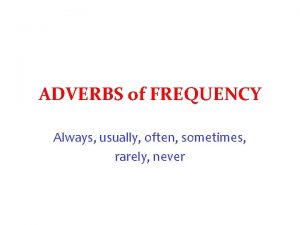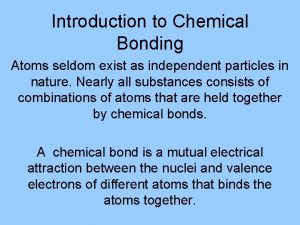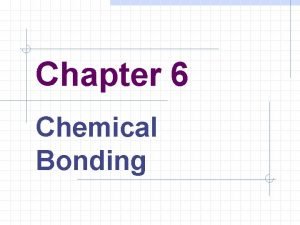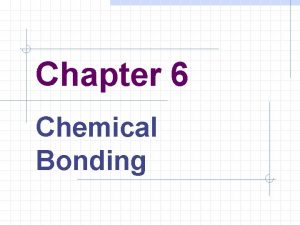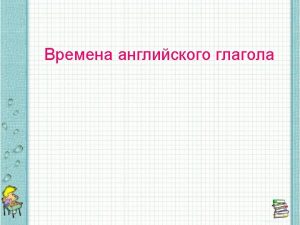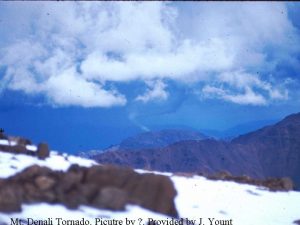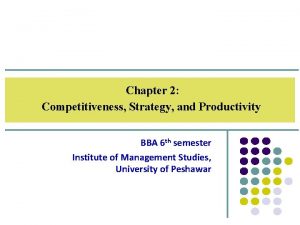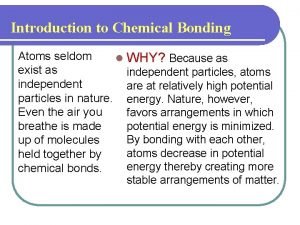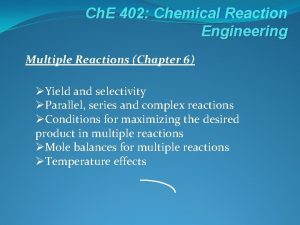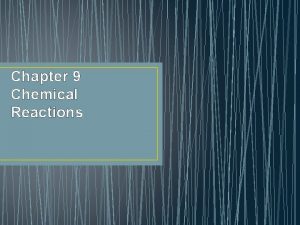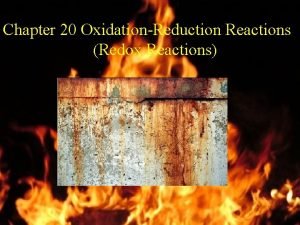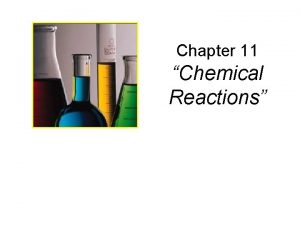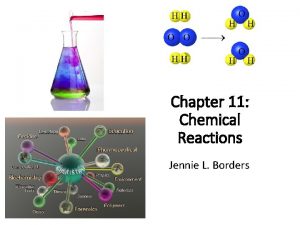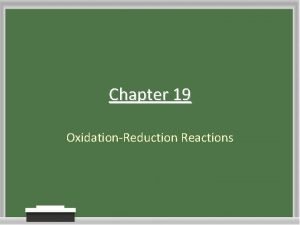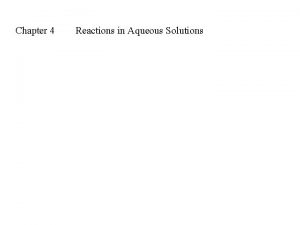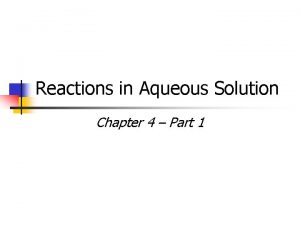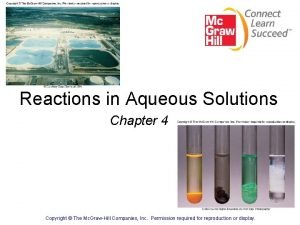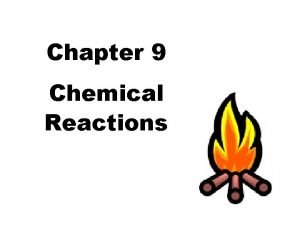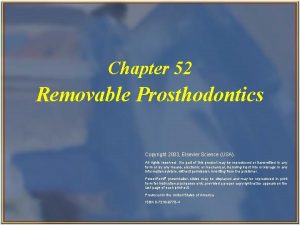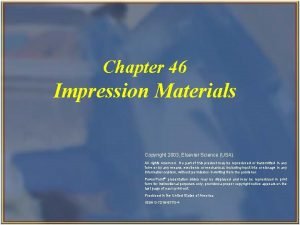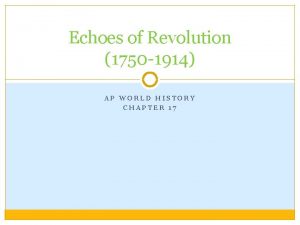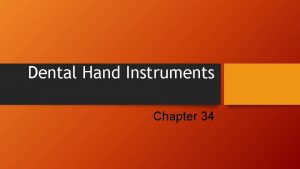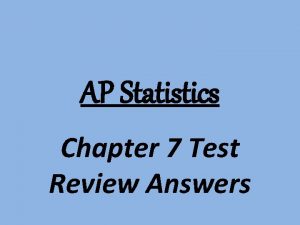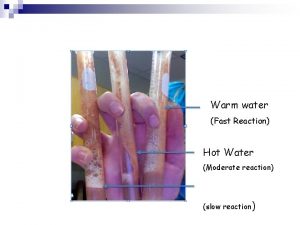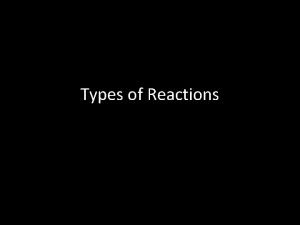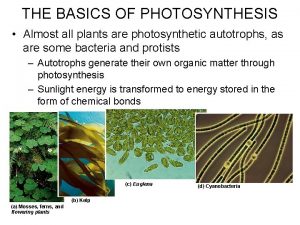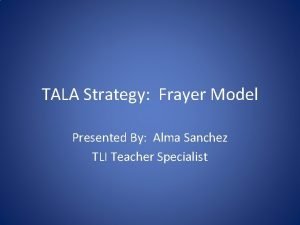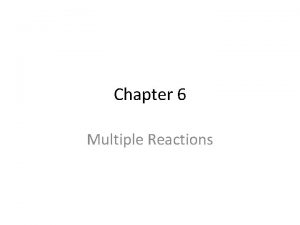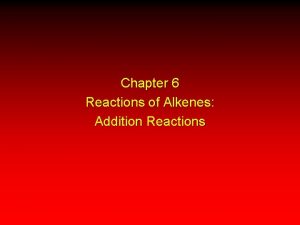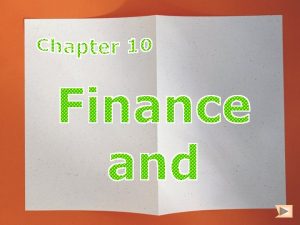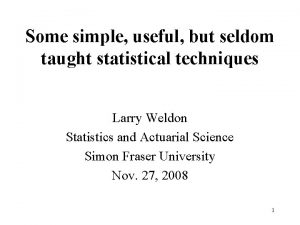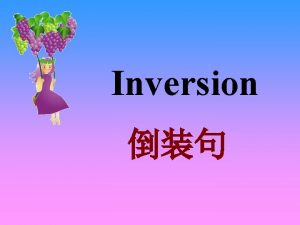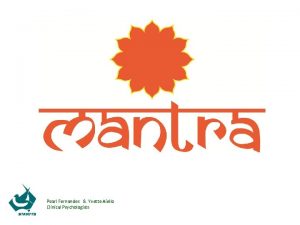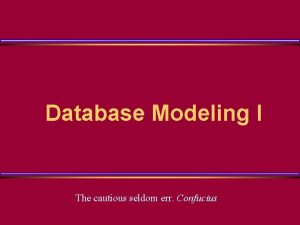Multiple Reactions Chapter 6 Multiple Reactions Seldom is


























































- Slides: 58

Multiple Reactions Chapter 6

Multiple Reactions • Seldom is the reaction of interest the only one occurs in the chemical reactor. Typically multiple reaction will occur, some desired and some undesired. • The key factor in economic success of chemical plant is minimizing the undesired side reactions.

Multiple Reactions The objectives of this chapter are 1. To discuss the general mole balance and reactor selection for multiple reaction. 2. Define different types of multiple reactions such as series, parallel, independent and complex reactions. 3. Define the selectivity parameters in terms of minimizing the undesired products. 4. Develop the algorithm to solve process with multiple reactions.





Desired & Undesired Reactions (Selectivity and Yield)

SD/U 1/U 2 CA

Example: Maximizing the Selectivity - Parallel Reactions Determine the instantaneous selectivity, SD/U, for the liquid phase reactions: Sketch the selectivity as a function of CA. Is there an optimum and if so what is it?

Solution Finding the optimum concentration: Use CSTR with exit concentration C*A

Solution In general if the order of desired product higher, then CA should be maintained higher (batch & PFR) are recommended If the order of undesired reaction is higher then CA should be maintained at minimum (CSTR is recommended)

Example: Finding the Selectivity For the elementary reactions: with k 1=0. 1 s-1 and k 2=0. 2 s-1 with CAO= 2 mol/dm 3. Plot the concentration of B and selectivity of B to C as a function of space time in a CSTR.

Solution CSTR A. Balance on Species A

B. Balance on Species B

C. Balance on Species C

The space time τ* is the minimum value of V (i. e. τ*, ) at which there is an acceptable molar flow rate of the desired product B from the CSTR.

What Type of Reaction is Taking Place? Three species were found in a CSTR. The following concentration data were obtained as a function of temperature. The initial concentration of the single reactant, A, was the same at all temperatures. Both B and C are products. CA 0 = 2 moles/dm 3 Run T (o. C) CA (mole/dm 3) CB (mole/dm 3) CC (mole/dm 3) 1 30 1. 7 0. 01 0. 29 2 50 1. 4 0. 03 0. 57 3 70 1. 0 0. 1 0. 90 4 100 0. 5 1. 25 5 120 0. 1 1. 80 0. 1 6 130 0. 01 1. 98 0. 01 Explain the above data, what type of reaction is taking place, independent, complex, series or parallel ?

Solution Observations At low temperatures 1) Little conversion of A 2) Little B formed 3) Mostly C formed (but not too much because of the low conversion - 15 to 30% - of A) At high temperatures 1) Virtually complete conversion of A 2) Mostly B formed

Data suggest 2 reactions Reaction (1) is dominant at high temperatures with Reaction (2) is dominant at low temperatures


Reactor selection and operation • Types of reactors – Batch reactor – PFR (with and without recycle) – CSTR (with and without recycle) – Semibatch reactors – Membrane reactor

Choice of reactor Example 6 -3





3. Algorithm for Multiple Reactions

3. Algorithm for Multiple Reactions 1. Number of reactions (1) A+2 B C (2) 3 A+C 2 D


(1) A+2 B C (2) 3 A+C 2 D

(1) A+2 B C (2) 3 A+C 2 D

(1) A+2 B C (2) 3 A+C 2 D

(1) A+2 B C (2) 3 A+C 2 D




Algorithm for Multiple Reactions 1. Mole Balance

2. Net Rate of Reaction for Species A

Elementary Multiple Reactions

Elementary Multiple Reactions Species A

Species B

Species C

Species D

Case 1: Liquid Phase Reaction in a CSTR


Polymath Solution

Example: Liquid Phase Reaction

Example: Liquid Phase Reaction

Example: Liquid Phase Reaction

Case 3: Semibatch Liquid Phase

Multiple Reactions — Gas Phase Use Molar Flow Rates!!!

Multiple Reactions — Gas Phase Reaction Rate

Multiple Reactions — Gas Phase

Multiple Reactions — Gas Phase

Multiple Reactions — Gas Phase Stoichiometry

Multiple Reactions — Gas Phase Combine

Multiple Reactions — Gas Phase
 Always often rarely never
Always often rarely never Atoms seldom exist as independent particles
Atoms seldom exist as independent particles Atoms seldom exist as independent particles
Atoms seldom exist as independent particles Lewis structure for c2hcl
Lewis structure for c2hcl Usually present simple
Usually present simple They seldom walk on the mountain
They seldom walk on the mountain Productivity and competitiveness in operations management
Productivity and competitiveness in operations management Disulfur decabromide formula
Disulfur decabromide formula Section 2 reinforcement classifying chemical reactions
Section 2 reinforcement classifying chemical reactions An example of redox reaction
An example of redox reaction Section 2 reinforcement classifying chemical reactions
Section 2 reinforcement classifying chemical reactions Types of reactions
Types of reactions Unit 5 chemical reactions answers
Unit 5 chemical reactions answers Chemical reaction engineering
Chemical reaction engineering Chapter 10 chapter assessment chemical reactions answers
Chapter 10 chapter assessment chemical reactions answers Chapter 9 chapter assessment chemical reactions
Chapter 9 chapter assessment chemical reactions Baseline
Baseline Multiple instruction multiple data
Multiple instruction multiple data Oxidation reduction reactions chapter 19 review
Oxidation reduction reactions chapter 19 review Chapter 9 chemical reactions
Chapter 9 chemical reactions Chapter 8 review chemical equations and reactions section 2
Chapter 8 review chemical equations and reactions section 2 Chapter 9 chemical reactions answers
Chapter 9 chemical reactions answers Chapter 8 section 1 chemical equations and reactions
Chapter 8 section 1 chemical equations and reactions Balancing equations chapter 8
Balancing equations chapter 8 Reducing agent strength table
Reducing agent strength table Chapter 11 chemical reactions answer key
Chapter 11 chemical reactions answer key Predict the products of the following reactions.
Predict the products of the following reactions. Chapter 18 chemical reactions balancing chemical equations
Chapter 18 chemical reactions balancing chemical equations Chapter 19 review oxidation-reduction reactions answers
Chapter 19 review oxidation-reduction reactions answers Chapter 19 chemical reactions simple word equations
Chapter 19 chemical reactions simple word equations Examples of double replacement reactions
Examples of double replacement reactions Chapter 4 reactions in aqueous solutions
Chapter 4 reactions in aqueous solutions Chapter 4 reactions in aqueous solutions
Chapter 4 reactions in aqueous solutions Chapter 4 reactions in aqueous solutions worksheet answers
Chapter 4 reactions in aqueous solutions worksheet answers Chapter 4 reactions in aqueous solutions
Chapter 4 reactions in aqueous solutions What are active metals
What are active metals Chapter 56 oral and maxillofacial surgery multiple choice
Chapter 56 oral and maxillofacial surgery multiple choice Prosthodontics definition
Prosthodontics definition Ch 52 removable prosthodontics fill in the blank
Ch 52 removable prosthodontics fill in the blank Ch 46 impression materials
Ch 46 impression materials Sign chapter 37
Sign chapter 37 Ap world history chapter 17 multiple choice questions
Ap world history chapter 17 multiple choice questions G v black instrument formula
G v black instrument formula Predisation
Predisation Ap statistics chapter 7 review
Ap statistics chapter 7 review Chapter 5 elasticity and its application multiple choice
Chapter 5 elasticity and its application multiple choice Enzyme cut-outs activity
Enzyme cut-outs activity Stoichiometry island diagram
Stoichiometry island diagram Examples of chemical change
Examples of chemical change Balancing redox reactions
Balancing redox reactions Types of reactions
Types of reactions Five types of reactions
Five types of reactions Example of single replacement reaction
Example of single replacement reaction 4 types of chemical reactions
4 types of chemical reactions How to identify type of reaction
How to identify type of reaction Predicting products of chemical reactions
Predicting products of chemical reactions 4 types of chemical reactions
4 types of chemical reactions Inputs of light reactions in photosynthesis
Inputs of light reactions in photosynthesis Non examples of chemical reactions
Non examples of chemical reactions
